Rhubarb-dividing time will be followed by pie-making season!
The very best time to divide and multiply your rhubarb patch is in the fall after the plants have gone dormant, but last fall followed that disastrous hot and dry summer, and I really didn’t want to pick on my poor rhubarb plants that way. I like them. I didn’t want to kill them. So I decided to go for the second-best time to divide and re-plant, and that is early spring. To be precise, yesterday.
Yesterday had all the hallmarks of a perfect rhubarb dividing and replanting day: a. my plants hadn’t started sending up their delicate stalks yet, b. there was rain forecasted for today (ensuring, hopefully, a thorough soaking), and c. my son Timothy was available to help me if I needed him.
Full disclosure time: to be honest, I had gone out the day before to Do This Thing. I have a decent-sized rhubarb patch, composed of a few young plants and a half-dozen older plants–they are overdue for dividing, as rhubarb benefits from being dug up and divided every five years or so. The plant, when happy, grows like a weed and eventually will suffer from overcrowding and even root-rot. The stalks will get smaller and it will be susceptible to disease. I reckon my original rhubarb patch is probably eight years old, I’m a little ashamed to admit. My pitiable older rhubarb plants really need dividing.
I’ve decided to just tackle one rhubarb plant each year, because once you dig up your plant and divide it into many baby plants, you’re going to have to leave them alone to grow and restore themselves for a year. If I dug all my older plants (as if that was physically possible) up this year, I’d have no rhubarb for sauces, cobblers, muffins, and pies, and that’s a dim prospect to consider. Very dim indeed.
Determining that this was the day, I carried out to the garden a shovel and started digging. Gosh, the ground was hard–was it still frozen? I minced away at the dirt with the shovel, pushing with my foot, jumping with both feet–but I could barely nick away the dirt. It was going to take a bit more time than I had originally reckoned to, um, do this thing.
Amalia called from the house. Bethie was on the ‘phone! I trudged back to the house and had a chummy chat with my college girl, and then grabbed a different spade (I was having trouble, you see, because I had the wrong shovel) and stumped out to the garden, and attacked the clump again. Wow. Jeepers! Maybe it was the drought last summer–could it have hardened the dirt? Had the dirt, possibly, gotten even harder while I was inside? This was much harder than I had anticipated it would be.
Amalia called from the house. Grandma was on her way out to visit! I set down my spade. Fine. I needed a break, anyway. This wasn’t such an easy job as I had thought! While back in the house, I’d see if Timothy could help me finish digging up the mammoth plant.
We had a nice visit with my mom, and then as I prepared to return to the garden, I had another call. And then another. Some days are just like that, aren’t they? I didn’t get back to the garden that day at all. My poor mama rhubarb plant was waiting for me, partly dug up and exposed to the elements. Poor thing.
The next day after school, Timothy agreed to help me. To be honest, I was curious to see my big strong son tackle that root. He is the strong and silent type–but it was going to make me feel a bit better if digging up that root was a challenge for him, too. Was the ground that hard or was I just a wimp without sufficient heft to dig up a rhubarb root, for Pete’s sake? I was dying to know. Kind of. And kind of: I didn’t want to know–you know??
Timothy appeared out at the garden, spade in hand . . .
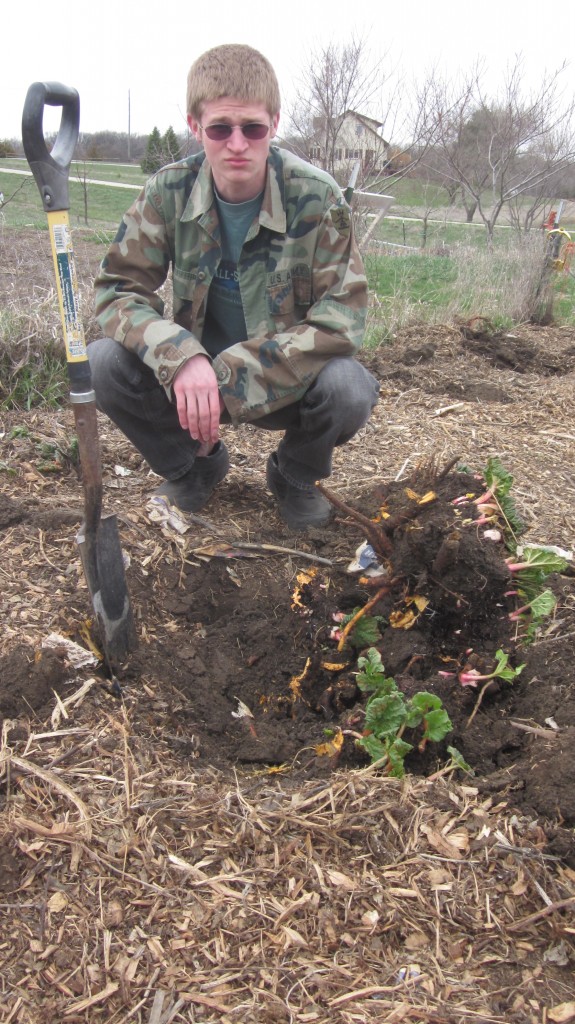
. . . 3 . . . ! Here he is giving me his “what’s the big deal, Mom and when will my pie be ready?” look.
Okay, so that answered my question. I was a wimp without sufficient heft to dig up a rhubarb root. Oh well. I can live with that. Hmph. That doesn’t bother me, as long as I’ve got a strong silent type around who likes rhubarb pie enough to do his mother’s bidding. And I do. For now, anyway.
Rhubarb is a fascinating plant with an interesting history. Here in Nebraska, it provides the first fruit of the season. My dad’s mom called it “pie plant.” We make it into jams and sauces and even wine, although rhubarb pie is probably hands-down my family’s favorite way to use rhubarb at our house. Ala mode, natch! It’s also a tasty addition in muffins and cobblers. I’m really just getting started here. It’s good in so many things.
Dividing a rhubarb plant is not only an important way to keep your plants healthy, but is also an easy way to make friends with your neighbors, because when you divide it, you’ll have many new plants to add to your patch or to share.
The mid-twentieth century garden writer, Arthur Symons, made this observation regarding rhubarb: “Although rhubarb is the most important permanent kitchen garden crop, it is often relegated to a dark out-of-the-way corner and neglected there until senile decay sets in.” Senile decay . . . I don’t like the sounds of that . . .
Assuming the “senile decay” is referring to the plant and not to the gardener, it is my opinion that we should pamper and cossett this plant with the delectable stalks to put off this decline.
So here are simple instructions for you, if you have some older rhubarb plants in need of attention in your garden. But don’t delay in this task–it’s much more difficult and much harder on the plant if you dig it up after it has sent up its stalks.
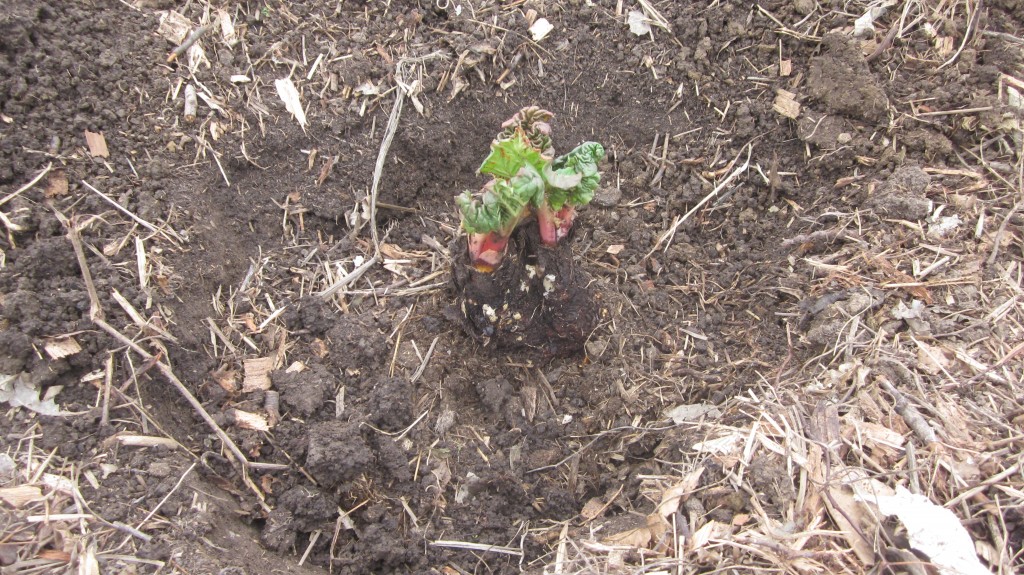
Here’s my cute baby rhubarb plant in its new home, waiting for me to finish filling the hole with compost and dirt.
- First, prepare where your new plants are going to go. Rhubarb is a greedy plant and will benefit from good amounts of compost or well-rotted manure worked into the planting site. Dig holes big enough to accommodate the size of crowns (or roots) that you intend to re-plant, and work generous amounts of compost or aged manure into the holes. The holes should be at least four feet apart.
- Use a sturdy spade to dig up your mama rhubarb plant. Ask for help if you’re a wimp like me. Divide your plant into pieces that include a rhizome, a piece of root, and a bud. There’s no gentle way to do this, but don’t worry, the only delicate parts of the rhubarb plant are the buds and shoots, and hopefully there aren’t many of them yet.
- Trim away any rotted areas on the roots, and don’t fret about it. This is a normal condition on an older plant. Discard the rotted parts.
- Move your baby rhubarb plants into their nicely-augmented holes, and settle them in nicely.
- Water well and mulch around the new plants with wood chips or straw.
- Call your neighbor that you’ve been meaning to visit, and offer them a rhubarb plant, if you’ve got extras left over.
Don’t pull any stalks from the newbie plants this summer, but you may start harvesting next spring.
There! That’s it! Admittedly, digging that mammoth plant up is no easy task, but the rest of this job is easy as . . . well, as pie. Especially if you have somebody with muscles around who doesn’t mind trading work for pie!


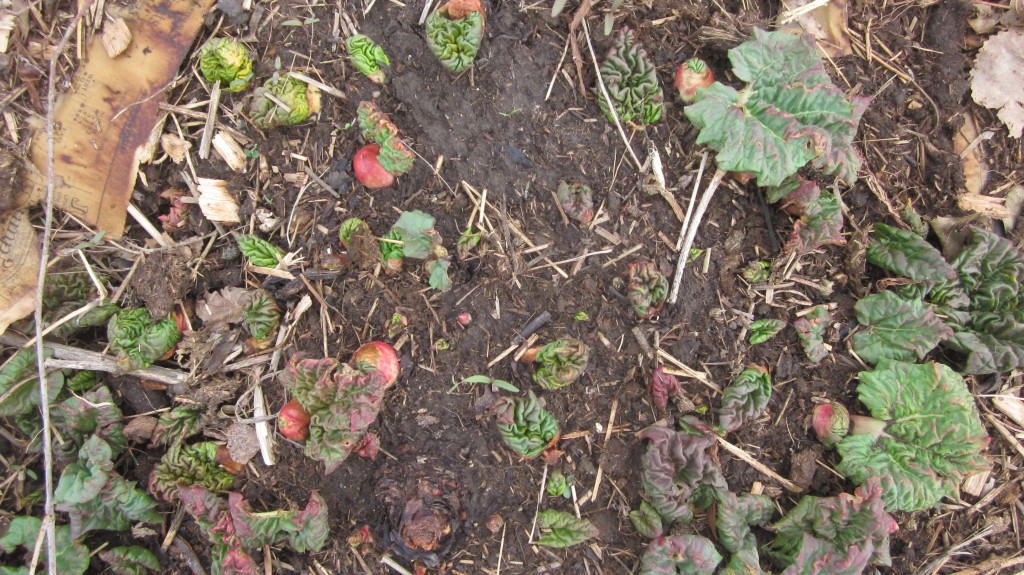
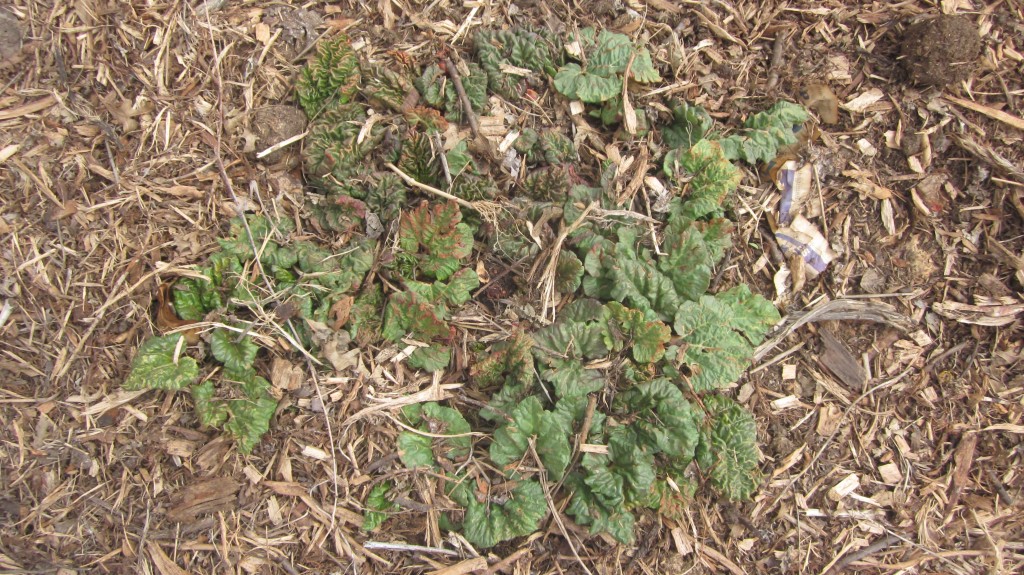
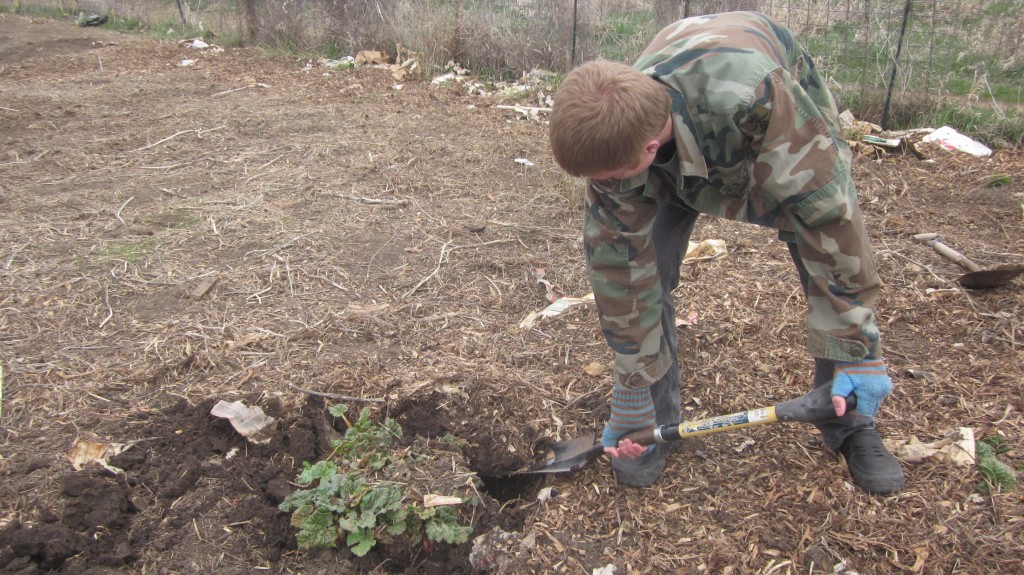
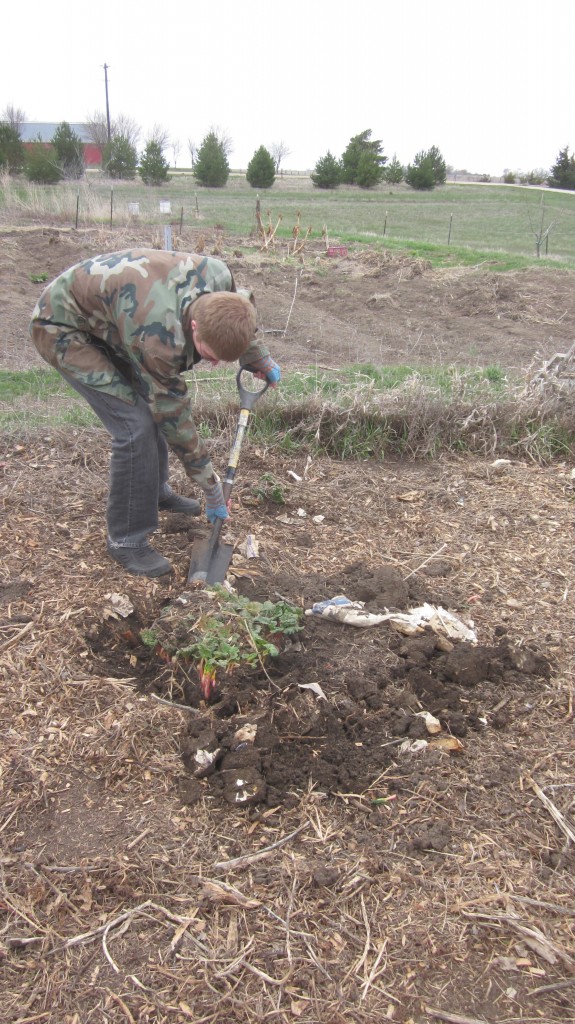
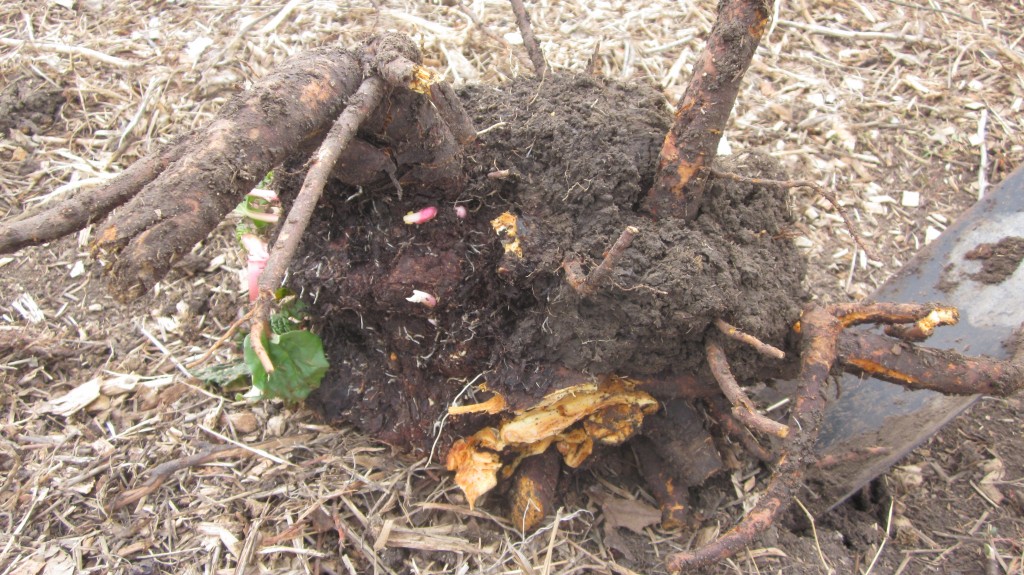
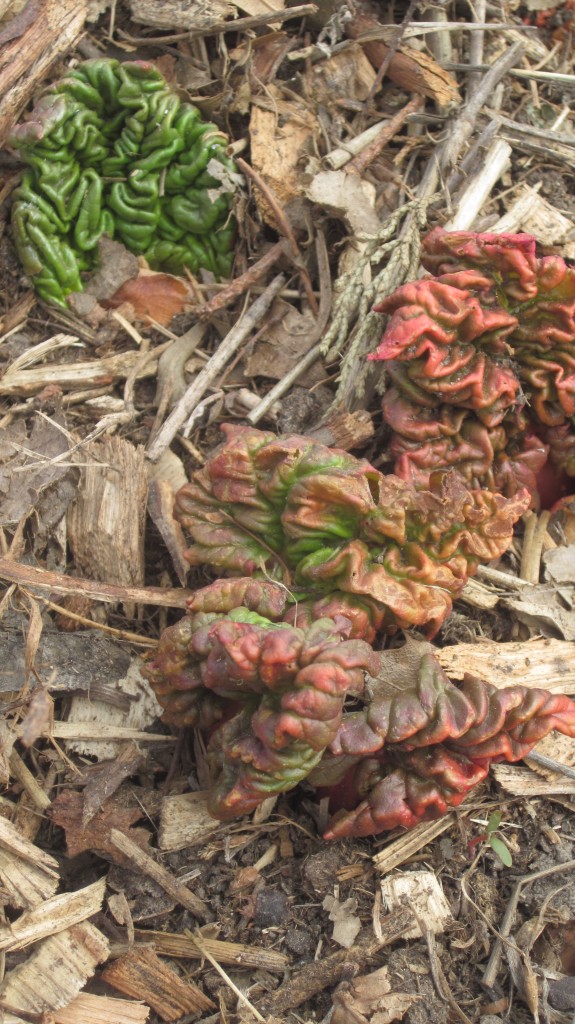
Growing up my grandmother made rhubarb pie all the time. I think she was the only one who ate it. Maybe if she would have made it into wine it would have been a bigger hit!
Oh how I feel badly for the rhubarb plants of my youth! We had them in the backyard, and never divided them. As kids, we would get the stalks and wet them, pour sugar on them, and eat. Yum!
Regina,
We used to do the same thing! Yum! Those old rhubarb plants are probably still growing away, although they could have multiplied many times if they had been dug up and divided! Do you have any now?
Not surprising that one does the same thing with rhubarb, as one does with strawberries. Except, many of us are more used to eating strawberries raw…
Roy,
Lots of people in our area dote on Strawberry-rhubarb pie, although I think rhubarb takes center stage. It’s a much stronger taste.
Amy, I am homesick for the farm I grew up on every time I read your posts! In a good way, not a bad way, so don’t feel bad! :>)
I love how you write and the story you tell creates such vivid pictures in my mind. Thank you!!
Thanks Melissa–I know what you mean. We lived in town until just 10 years ago, and the whole time the country was calling my name–thanks for your nice words!
I LOVE rhubarb almost TOO much – and miss my plants. (I’m not surrounded by black walnut trees 🙁 )
So excited I found this blog!!!
Sara, I’m glad you found me, too!
Oh, how I miss thee, dear rhubarb! ;(
That whole process is very similar to what I do with my daylilies. I few years back, I decided to try to make it easy on myself…(I have SO MANY gorgeous daylilies and they were also overdue for dividing)… so I had a Daylily Dividing Party. I invited friends in the fall to bring their spades, shovels, etc. I cooked them a delicious lunch of soup, bread, and salad, and then we all got to work. Everyone got to take daylilies home with them and it was a lot of fun. I think we are due again. Thank you for the reminder. And I love rhubarb pie, btw. You made my mouth water!
WOW this is brilliant, Suerae! I have some daylilies that need to be dug up and re-planted. That is BRILLIANT–a party! Thanks for sharing that with me! (would be a fun thing to write about, too!) 😉
As usual, your articles do not disappoint! Your life fascinates me to no end. From egg bound chickens to rhubarb. I love reading the daily accounts of your life!
Thanks Susie, you are so sweet.
I might have to think about rhubarb…dang, girl…
hahaha Carrie! I have a couple of starts here if you want to come get them! 😉
Tried to divide hostas once – ouch. Now that I have an official Bad Back, neither the hostas nor anything else will get divided without the help of a Strong Person. Fortunately for my back, I do not like rhubarb and the one rhubarb plant we had (planted by the previous owner of this house) was stolen….long story.
. . . stolen rhubarb, Alana? Now that’s a story I’d like to hear. 😉
A lovely sight indeed!
And Amy…of course you loosened the soil for Timmy!
Anne
Oh yeah–of course! Thanks, Anne!
I had no idea how much work it would be to grow rhubarb and it’s such a crazy looking plant. I’ve only seen it growing a few times and both were in much colder climates than Texas – no one in my family ever planted it! Perhaps because it’s so much work?? Who knows! I can tell you that my husband grew up eating it and loves it, especially stewed with strawberries and made into a pie or served over ice cream. I have a 14 year old son who I get to do the heavy lifting for me and he is always so proud to help out. He planted an orange tree when we moved into our new house and had to dig up the huge root system from a year old banana tree that feel over in a windstorm… but he’s not the silent type 🙂 Happy planting Amy.
thanks Minette! Rhubarb doesn’t have to be a lot of work; I’ve known people who never dug it up and replanted it at all, but if you want to get the most out of your plant, that’s what you do. Glad you’ve got muscles in your house to do the heavy digging! 🙂
I love rhubarb. This post is fantastic and I will be taking on board those wonderful tips. Don’t forget to save some rhubarb for your rhubarb margaritas 🙂
Oh yes! Shoot, I wish I would have remembered to include a link to that post, Anita-Clare. Well–I will when I write a post about using rhubarb in the kitchen–once it has all come up! But we have snow here today, so it may still be a week or two . . . thanks for the comment, chickie!
You remind me of my childhood where we had a rhubarb patch. Might buy some at the markets tomorrow as i have recently learned it is good for my bones
Rhubarb is good for the bones? I didn’t know that! Thanks Suzie!
Some of my kids love eating raw rhubarb out of the ground with no sugar.
I have 2 nice plants that I can finally harvest from this year…my smallest one is already multiplying and I am thrilled…I have them a few feet from my strawberry tower…cannot wait to make a pie….yummmmmm
Strawberries + Rhubarb + pastry = Sublime experience. Add a scoop of ice cream = Heaven help me. Yummmmmmmmmm Marya. Brilliant plan to plant them close together. Oh, hey, they are next door neighbors in my garden, too! Smart minds, etc.